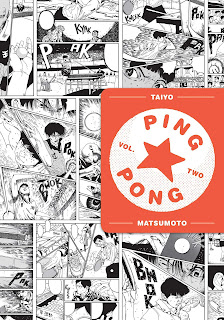Taiyō Matsumoto's manga Ping Pong was released as two-volumes in English last year. It was pretty highly touted since it was originally serialized in Japan back in 1996, which were then collected later that year. And then made into a live-action movie in 2002. And then re-released in a new format in 2012. And then made into an eleven-episode anime in 2014, which saw Blu-ray and DVD releases in 2015. I believe last year's manga release from Viz consituted the first time the original has seen print in English (at least officially here in the US) so with nearly a quarter century of proven Japanese popularity behind it -- not to mention some of Matsumoto's prior works earned him a variety of awards, including an Eisner in 2007 for Tekkonkinkreet -- Ping Pong not surprisingly was much anticipated.
The story is follows two teenage friends, Peco and Smile, who have become quite skilled at Ping Pong. Peco had a very natural talent for the game and he was the one who originally taught Smile. Smile also has fairly natural talent for table tennis, but it's not nearly as tied to his seense of self as it is for Peco. They find themselves at some tournaments and, amid the games themselves, have to both com to terms with who they are as individuals and in particular in their relationship to ping pong.
When I first heard of the sports manga genre, I was largely disinterested. I'm not much of a sports guy in the first place, and I didn't see much appeal in reading a story about it. I did check out a few some years back just to see how the stories were handled and quickly saw that the sports are often just a narrative hook for a character facing (generally internal) adversity. You could swap out many of the sports asthetics for other hobbies and professions, and the overall narrative wouldn't change all that much. Racing for a writing deadline instead of watching the shot clock, or improving their swordsmanship to defeat the local thugs instead of improving their batting abilities to defeat the team across town. It's more about seeing the characters face challenges and grow as individuals, not the actual games themselves.
That said, Matsumoto did seem to do his homework for this. I'm no table tennis expert, by any means, but I'm familiar enough with the game to know he was drawing and talking about solid game mechanics. You certainly don't need to know much of anything about ping pong to follow the story (again, it's more about the characters than the game) but the details are there if you're into that.
In fact, much of what is shown for the games doesn't really convey the actual games themselves anyway. What Matsumoto frequently does here is show impressions of the games through a variety of what you might call mood shots. A close-up of the player's eyes. A sneaker skidding to halt on the floor. Re-positioning their grip on a paddle. A super close-up of the ball itself. A bead of sweat rolling down their arm. A shot of the crowd in tense anticipation. The reader doesn't see the games so much as get a sense of them. For the most part, the individual strikes and how the ball is returned are irrelevant. You just need to know if the players are evenly matched, how intense they might be playing, that kind of thing.
From a technical perspective, I thought there was a lot Ping Pong had to offer. The way Matsumoto handles the page- and panel-level narration is excellent, and he uses a variety of illustration techniques that do a great job emphasizing the action (or lack thereof) in a given panel. I did have a little trouble differentiating individual members of one of the opposing teams because they were all similarly-built guys who shaved their heads, but they only show up for tournaments (which include announcers) and that didn't cause any real problems with understanding the story.
However, I just didn't find myself getting into the story at all. I found the depictions of the games technically well-executed, but they got tedious for me really quickly. They were individually unique but thematically identical, and that repitition got stale for me. I also could not find myself connecting much with either Peco or Smile; they were well-rounded enough, I suppose, but I didn't see anything in either character I could really relate to. Maybe it's because I knew of too much hype before reading it, and my expectations were too high; maybe it was my pandemic-distracted brain that kept me from focusing on the characters enough; maybe I'm just not a sports manga person at all. I didn't really find anything I disliked about it per se -- like I said, the technical execution was very good by and large -- but I didn't find anything I especially liked about it either. It hasn't put me off Matsumoto's work, but I'm not exactly eager to track down more.
Now Available!
Blog Archive
-
▼
2021
(290)
-
▼
January
(23)
- Weekly Recap
- Wouldn't It Just Be More Interesting for the Artist?
- What ELSE was in Amazing Fantasy 15
- Cleveland Scene Comics
- The Red Blazer Circa 1941
- The Black Panther Party Review
- Weekly Recap
- What's With Those Weird Color Bars Across The Tops...
- A Short Primer on Marketing Lingo
- Naver Buys Wattpad
- Invisible Men Review
- King The Special Edition Review
- Weekly Recap
- The History of Mr. Tuberculus
- Eddie's Week Review
- Comics Events
- Chucky Jack's A-Comin Review
- Weekly Recap
- Read DC Axed
- Staying Safe
- The State of Retail
- Ping Pong Review
- Closing My Patreon
-
▼
January
(23)







0 comments:
Post a Comment